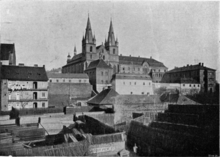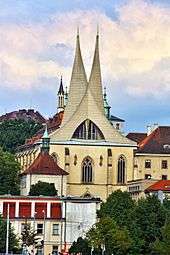1945 Bombing of Prague

The Bombing of Prague occurred towards the end of World War II on February 14, 1945, when the US Army Air Forces carried out an air raid over Prague. The city was the capital of Czechoslovakia and (since the Nazi occupation in 1939) the main city of the Protectorate of Bohemia and Moravia. According to American pilots, it was the result of a navigation mistake: at the same time, a massive bombing of Dresden was under way, 120 km north-west from Prague.
Impact of the attack


Forty B-17 Flying Fortresses of the 8th American Air Force dropped about 152 tons of bombs on many populated areas of Prague. The carpet-bombing hit Vyšehrad, Zlíchov, Karlovo náměstí, Nusle, Vinohrady, Vršovice and Pankrác. The bombing resulted in the deaths of 701 people and the wounding of 1,184. About one hundred houses and historical sites were totally destroyed and another two hundred were heavily damaged. All the casualties were civilians and not one of the city's factories, which might have been of use to the Wehrmacht, were damaged.
Many homes and national sites were destroyed, for example the Emmaus Monastery, Faust House and Vinohrady Synagogue. Some of Prague's famous modern buildings, such as the Dancing House or the Emauzy church, were constructed in locations where bombs had destroyed previously existing buildings.
One of the pilots of the lead group was Lt. Andrew Andrako flying B-17 serial number 43-38652 V, "Stinker Jr.". Lt. Andrako was of Czech descent.[1]
Controversy
The American pilots have voiced their regret many times. The history of the 398th Bombardment Group based at RAF Nuthampstead, which carried out the raid, indicates the attack was an accident. The radar navigational equipment on the aircraft was not functioning correctly and high winds en route produced a dead reckoning navigational error of some 70 miles. This caused the formation to arrive over the supposed "target", which was believed to be Dresden, at the time bombing commenced. Prague was mostly obscured by broken clouds, with occasional glimpses of the Vltava river. Additionally, Prague and Dresden looked similar from the air, with rivers running through both cities. The bombing was carried out as a "blind attack" using radar.
After the war, the Americans were billed for some of the damages sustained by the historical buildings. The raid was used for anti-American propaganda purposes, both by the Nazis and the subsequent Communist regime in Czechoslovakia.[2]